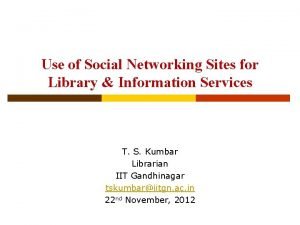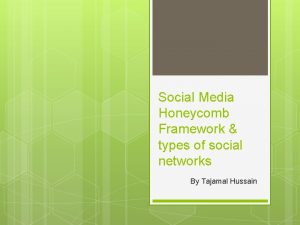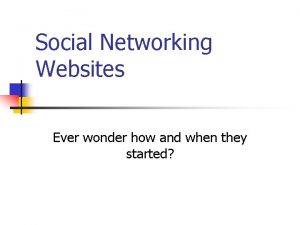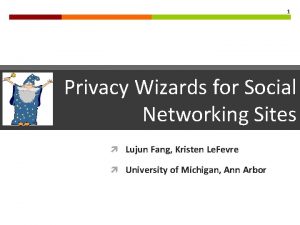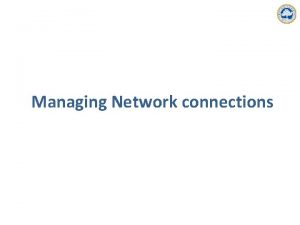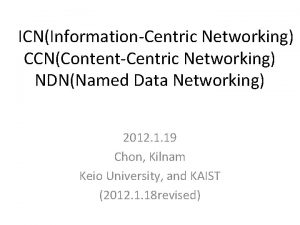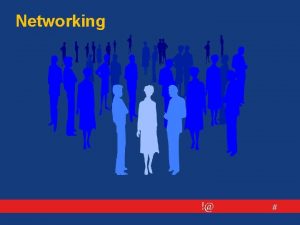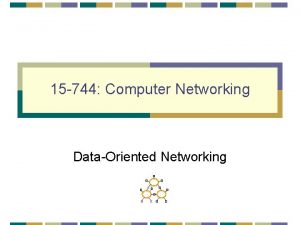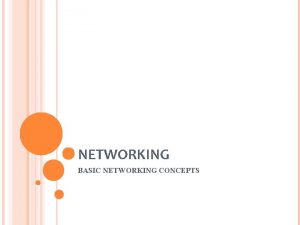SOCIAL NETWORKING A social network is a social







- Slides: 7

SOCIAL NETWORKING A social network is a social structure made up of a set of social actors (such as individuals or organizations) and a set of the dyadic ties between these actors. The social network perspective provides a set of methods for analyzing the structure of whole social entities as well as a variety of theories explaining the patterns observed in these structures. [1] The study of these structures uses social network analysis to identify local and global patterns, locate influential entities, and examine network dynamics. Social networks and the analysis of them is an inherently interdisciplinary academic field which emerged from social psychology, sociology, statistics, and graph theory. Georg Simmel authored early structural theories in sociology emphasizing the dynamics of triads and "web of group affiliations. "[2] Jacob Moreno is credited with developing the first sociograms in the 1930 s to study interpersonal relationships. These approaches were mathematically formalized in the 1950 s and theories and methods of social networks became pervasive in the social and behavioral sciences by the 1980 s. [1][3] Social network analysis is now one of the major paradigms in contemporary sociology, and is also employed in a number of other social and formal sciences. Together with other complex networks, it forms part of the nascent field of network science.

OVERVIEW A social network is a theoretical construct useful in the social sciences to study relationships between individuals, groups, organizations, or even entire societies (social units, see differentiation). The term is used to describe a social structure determined by such interactions. The ties through which any given social unit connects represent the convergence of the various social contacts of that unit. This theoretical approach is, necessarily, relational. An axiom of the social network approach to understanding social interaction is that social phenomena should be primarily conceived and investigated through the properties of relations between and within units, instead of the properties of these units themselves. Thus, one common criticism of social network theory is that individual agency is often ignored[6] although this may not be the case in practice (see agent-based modeling). Precisely because many different types of relations, singular or in combination, form these network configurations, network analytics are useful to a broad range of research enterprises. In social science, these fields of study include, but are not limited to anthropology, biology, communication studies, economics, geography, information science, organizational studies, social psychology, sociology, and sociolinguistics.

HISTORY In the late 1800 s, both Émile Durkheim and Ferdinand Tönnies foreshadowed the idea of social networks in their theories and research of social groups. Tönnies argued that social groups can exist as personal and direct social ties that either link individuals who share values and belief (Gemeinschaft, German, commonly translated as "community") or impersonal, formal, and instrumental social links (Gesellschaft, German, commonly translated as "society"). [7] Durkheim gave a nonindividualistic explanation of social facts, arguing that social phenomena arise when interacting individuals constitute a reality that can no longer be accounted for in terms of the properties of individual actors. [8] Georg Simmel, writing at the turn of the twentieth century, pointed to the nature of networks and the effect of network size on interaction and examined the likelihood of interaction in loosely-knit networks rather than groups. [9] Major developments in the field can be seen in the 1930 s by several groups in psychology, anthropology, and mathematics working independently. [6][10][11] In psychology, in the 1930 s, Jacob L. Moreno began systematic recording and analysis of social interaction in small groups, especially classrooms and work groups (see sociometry). In anthropology, the foundation for social network theory is theoretical and ethnographic work of Bronislaw Malinowski, [12] Alfred Radcliffe-Brown, [13][14] and Claude Lévi-Strauss. [15] A group of social anthropologists associated with Max Gluckman and the Manchester School, including John A. Barnes, [16] J. Clyde

LEVELS OF ANALYSIS In general, social networks are self-organizing, emergent, and complex, such that a globally coherent pattern appears from the local interaction of the elements that make up the system. [33][34] These patterns become more apparent as network size increases. However, a global network analysis[35] of, for example, all interpersonal relationships in the world is not feasible and is likely to contain so much information as to be uninformative. Practical limitations of computing power, ethics and participant recruitment and payment also limit the scope of a social network analysis. [36][37] The nuances of a local system may be lost in a large network analysis, hence the quality of information may be more important than its scale for understanding network properties. Thus, social networks are analyzed at the scale relevant to the researcher's theoretical question. Although levels of analysis are not necessarily mutually exclusive, there are three general levels into which networks may fall: micro-level, meso-level, and macro-level.

MICRO LEVEL At the micro-level, social network research typically begins with an individual, snowballing as social relationships are traced, or may begin with a small group of individuals in a particular social context. Social network diagram, micro-level. Dyadic level: A dyad is a social relationship between two individuals. Network research on dyads may concentrate on structure of the relationship (e. g. multiplexity, strength), social equality, and tendencies toward reciprocity/mutuality. Triadic level: Add one individual to a dyad, and you have a triad. Research at this level may concentrate on factors such as balance and transitivity, as well as social equality and tendencies toward reciprocity/mutuality. [36] Actor level: The smallest unit of analysis in a social network is an individual in their social setting, i. e. , an "actor" or "ego". Egonetwork analysis focuses on network characteristics such as size, relationship strength, density, centrality, prestige and roles such as isolates, liaisons, and bridges. [38] Such analyses, are most commonly used in the fields of psychology or social psychology, ethnographic kinship analysis or other genealogical studies of relationships between individuals. Subset level: Subset levels of network research problems begin at the micro-level, but may cross over into the meso-level of analysis. Subset level research may focus on distance and reachability, cliques, cohesive subgroups, or other group actions or behavior

MESO LEVEL Organizations: Formal organizations are social groups that distribute tasks for a collective goal. [40] Network research on organizations may focus on either intra-organizational or inter-organizational ties in terms of formal or informal relationships. Intra-organizational networks themselves often contain multiple levels of analysis, especially in larger organizations with multiple branches, franchises or semiautonomous departments. In these cases, research is often conducted at a workgroup level and organization level, focusing on the interplay between the two structures. [40] Randomly-distributed networks: Exponential random graph models of social networks became stateof-the-art methods of social network analysis in the 1980 s. This framework has the capacity to represent social-structural effects commonly observed in many human social networks, including general degreebased structural effects commonly observed in many human social networks as well as reciprocity and transitivity, and at the node-level, homophily and attribute-based activity and popularity effects, as derived from explicit hypotheses about dependencies among network ties. Parameters are given in terms of the prevalence of small subgraph configurations in the network and can be interpreted as describing the combinations of local social processes from which a given network emerges. These probability models for networks on a given set of actors allow generalization beyond the restrictive dyadic independence assumption of micro-networks, allowing models to be built from theoretical structural foundations of social behavior. [41] Examples of a random network and a scale-free network. Each graph has 32 nodes and 32 links. Note the "hubs" in the scale-free diagram (on the right). Scale-free networks: A scale-free network is a network whose degree distribution follows a power law, at least asymptotically. In network theory a scale-free ideal network is a random network with a degree distribution that unravels the size distribution of social groups. [42] Specific characteristics of scale-free networks vary with theories and analytical tools used to create them, however, in general, scale-free networks have some common characteristics. One notable characteristic in a scale-free network is the relative commonness of vertices with a degree that greatly exceeds the average. The highest-degree nodes are often called "hubs", and may serve specific purposes in their networks, although this depends greatly on the social context. Another general characteristic of scale-free networks is the clustering coefficient distribution, which decreases as the node degree increases. This distribution also follows a power law. [43] The Barabási model of network evolution shown above is an example of a scale-free network.

MACRO LEVEL Organizations: Formal organizations are social groups that distribute tasks for a collective goal. [40] Network research on organizations may focus on either intra-organizational or inter-organizational ties in terms of formal or informal relationships. Intra-organizational networks themselves often contain multiple levels of analysis, especially in larger organizations with multiple branches, franchises or semiautonomous departments. In these cases, research is often conducted at a workgroup level and organization level, focusing on the interplay between the two structures. [40] Randomly-distributed networks: Exponential random graph models of social networks became stateof-the-art methods of social network analysis in the 1980 s. This framework has the capacity to represent social-structural effects commonly observed in many human social networks, including general degreebased structural effects commonly observed in many human social networks as well as reciprocity and transitivity, and at the node-level, homophily and attribute-based activity and popularity effects, as derived from explicit hypotheses about dependencies among network ties. Parameters are given in terms of the prevalence of small subgraph configurations in the network and can be interpreted as describing the combinations of local social processes from which a given network emerges. These probability models for networks on a given set of actors allow generalization beyond the restrictive dyadic independence assumption of micro-networks, allowing models to be built from theoretical structural foundations of social behavior. [41] Examples of a random network and a scale-free network. Each graph has 32 nodes and 32 links. Note the "hubs" in the scale-free diagram (on the right). Scale-free networks: A scale-free network is a network whose degree distribution follows a power law, at least asymptotically. In network theory a scale-free ideal network is a random network with a degree distribution that unravels the size distribution of social groups. [42] Specific characteristics of scale-free networks vary with theories and analytical tools used to create them, however, in general, scale-free networks have some common characteristics. One notable characteristic in a scale-free network is the relative commonness of vertices with a degree that greatly exceeds the average. The highest-degree nodes are often called "hubs", and may serve specific purposes in their networks, although this depends greatly on the social context. Another general characteristic of scale-free networks is the clustering coefficient distribution, which decreases as the node degree increases. This distribution also follows a power law. [43] The Barabási model of network evolution shown above is an example of a scale-free network.


